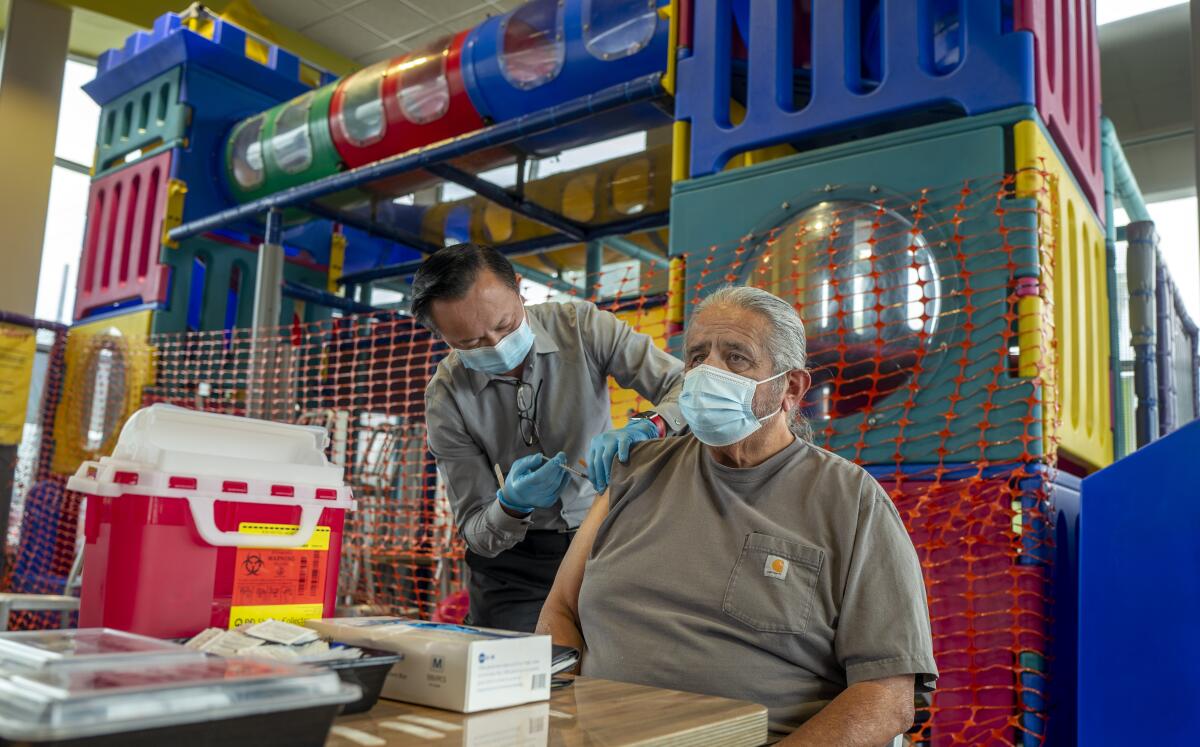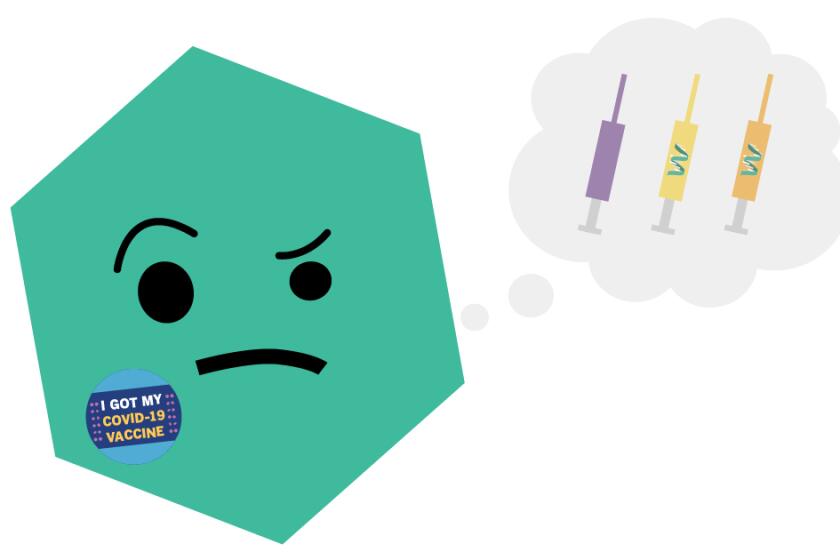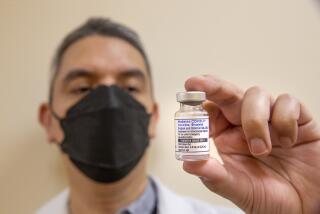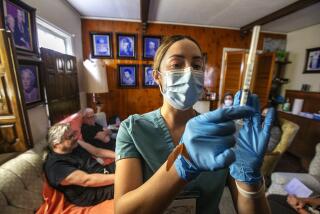Far fewer Californians getting COVID-19 booster shots than expected, bringing new alarms

- Share via
Demand for COVID-19 booster shots in California has been slower than some health officials anticipated, according to data obtained by The Times, sparking new concerns of at-risk populations losing immunity as the risky holiday season approaches.
The alarm is particularly high for elderly people and those with compromised immune systems, groups who have the highest risk of suffering severe consequences or death from breakthrough infections. Officials are also strongly recommending that all recipients of the Johnson & Johnson vaccine get a booster shot.
Numbers from the California Department of Public Health show that initial demand for booster shots has been much lower than originally expected. After federal officials enthusiastically urged some recipients of the Pfizer-BioNTech vaccinations to get booster shots, California authorities anticipated demand would peak the first full week of October.
COVID-19 vaccine boosters are now available. But, they’re only recommended for some people. See if you are eligible here.
But only 230,000 booster shots were administered to seniors that week, just 21% of the projected demand of 1.1 million. And for adults under 65, just 450,000 booster doses were administered that week — just 17% of the expected demand of 2.7 million.
Even early demand for third doses by immune-compromised people who had received both Pfizer-BioNTech and Moderna vaccine doses has been low. As of late September, only about 425,000 of an estimated 700,000 to 800,000 Californians in this group had received a third dose.
Health officials across the state, from San Francisco to the Central Valley to L.A., are reporting less-than-ideal rates of booster shots administered. In San Francisco, only 20% of eligible seniors have received an additional dose as of late October; in Los Angeles County, just 27% of fully immunized seniors have done so.
Only 9% of L.A. County’s nursing homes have completed booster vaccine clinics for their residents.
Scientists have been warning that the immunity offered by vaccines can wane six months after getting the last dose in the original Pfizer-BioNTech and Moderna series, and two months after getting the Johnson & Johnson shot.
“Where it’s really showing up as a problem is in the increased ability for people to end up more seriously ill,” L.A. County Public Health Director Barbara Ferrer said Thursday. “Many of us know friends or family members that also have experienced post-vaccination infections at this point.”
With such a low rate of uptake in boosters, “this leaves many of our seniors at risk for hospitalization in the coming months, as increased contact with friends and family during the holiday season gives the virus opportunities to spread,” the San Francisco Department of Public Health warned.
“Our seniors are experiencing waning immunity because they were among the first to get vaccinated nearly a year ago,” Dr. Naveena Bobba, San Francisco’s deputy director of health, said in a statement. “We are urging seniors to get their boosters as soon as possible.”
Former Secretary of State Colin Powell, 84, who was fully vaccinated and had cancer, had not yet received his booster before falling ill with COVID-19, from which he never recovered. Los Angeles Mayor Eric Garcetti, 50, who got his second shot of the Moderna vaccine in February but hadn’t received a booster, also recently reported a breakthrough infection while attending a U.N. climate summit in Scotland and has a fever.
The concern is acute in the San Joaquin Valley, where COVID-19 hospitalizations have already been rising in a region that has among the lowest rates of overall vaccinations in the state. And time is running out before families and friends start gathering for the holidays.
“We have so many people that are still unvaccinated, so many people that haven’t yet gotten their boosters,” Dr. Rais Vohra, the interim Fresno County health officer, said at a briefing recently. “We have approximately three weeks left before Thanksgiving weekend and we know that’s historically been when we start to see a real uptick in the number of respiratory viruses.”
Vaccinations remain highly effective — especially in reducing the chance of severe hospitalization and death. In L.A. County, of 5.9 million fully vaccinated residents, 1.2% have subsequently tested positive for the coronavirus, 0.039% have been hospitalized for COVID-19 and 0.006% have died.
Still, that means that more than 68,000 fully vaccinated residents in L.A. County have subsequently come down with a confirmed infection. Vaccinated people with breakthrough coronavirus infections are capable of transmitting the virus to others.
“When community transmission is higher, we can expect that more vaccinated people will also develop infections — although always at a much lower rate than unvaccinated people,” Ferrer said. “We can also expect that a small subset of vaccinated individuals, likely to be the oldest and most medically fragile among them, will end up hospitalized. And unfortunately, some may even pass away.
“This is because unvaccinated people create risks for everyone. Vaccination cannot entirely immunize us against the consequences of the chances unvaccinated people take,” Ferrer said. “Their risk eventually spills over into that for vaccinated residents. And it is leading all of us to continuing to take additional protections, like masking, to reduce the chances of getting and passing on the virus.”
Ferrer said she was hopeful that demand for boosters will increase now that, as of late October, the eligibility criteria became simplified. Starting in late September, only certain groups of people who originally got the Pfizer-BioNTech vaccine were eligible for the booster. But by late October, members of those groups could get boosters no matter what initial vaccination brand they had received.
L.A. County’s goal is to offer booster doses to all residents of nursing homes that want one by Nov. 20, Ferrer said.
Currently, the U.S. Centers for Disease Control and Prevention recommends all seniors age 65 and over, adults age 50 and over with underlying health conditions, and adults living in long-term care facilities get a booster shot. All adults who got the single-dose J&J shot are also urged to get a booster at least two months after the original jab.
Those who got the two-dose Pfizer-BioNTech or Moderna shots need to wait at least six months after the second dose before getting a booster.
The CDC also said adults up to age 49 with underlying health conditions, as well as adults age 18 to 64 at increased risk for coronavirus exposure at work or home, are eligible for the booster shot. The CDC, however, stopped short of officially recommending it for everyone in those groups.
The subtle distinction may have led some elected officials to take differing decisions on getting booster shots. Garcetti hadn’t received a booster before he left L.A. on Sunday, and a spokesman for the mayor said he plans to get a booster “as soon as it’s recommended he do so.”
By contrast, Oakland Mayor Libby Schaaf got a Pfizer booster to follow up her original two-dose Pfizer vaccination at a press conference with Gov. Gavin Newsom on Oct. 27. “I got my booster today because my work entails a lot of public contact,” Schaaf, 55, said.
Newsom, 54, got a Moderna booster to his original J&J vaccination.
Dr. Anthony Fauci, the U.S. government’s top infectious diseases expert, recently outlined growing evidence that booster shots work. Fauci cited a study published in the journal Lancet that found that, compared to people in Israel who received two doses of the Pfizer-BioNTech vaccine, people who got a third dose had a 93% lower risk for COVID-related hospitalization, a 92% lower risk of severe disease, and an 81% lower risk of COVID-related death.
Fauci said the dramatic improvement in effectiveness raises the question whether scientists may, in the future, consider the booster shot as part of the formal vaccination sequence.
There are still concerns there could be a fifth wave of COVID-19 this fall and winter. COVID-19 hospitalizations have stopped declining in L.A., San Diego, Orange, and Ventura counties, and are increasing in Riverside and San Bernardino counties.
“It’s troubling to continue to see a slight uptick in cases and now, obviously, no decline here in our hospitalizations,” Ferrer said. “We’ve got to do what we know works: get more people vaccinated, wear our masks when we’re indoors.”
Ferrer said she and hospitals are prepared for a worsening in the pandemic.
“We’re hoping, at best, it’s a small bump up and nothing like what we saw last winter. But that takes all of us to get there,” Ferrer said. “As long as there’s a lot of circulation of the virus — that as you can see from our data — fueled, unfortunately, by those that are not yet vaccinated, all of us who are vaccinated are going to be at increased risk.”
More to Read
Sign up for Essential California
The most important California stories and recommendations in your inbox every morning.
You may occasionally receive promotional content from the Los Angeles Times.














